Canon EOS 450D / Digital Rebel XSi
-
-
Written by Gordon Laing
Canon EOS 450D / Rebel XSi lens and stabilisation
The Canon EOS 450D / XSi employs an EF lens mount and is fully compatible with both Canon EF and EF-S lenses. Thanks to its APS-C sensor size, all lenses effectively have their field of view reduced by 1.6 times.
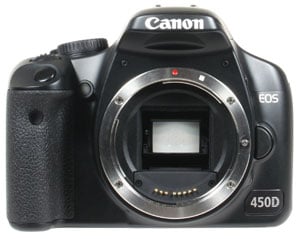 |
The EOS 450D / XSi is available as a body alone or in a kit with Canon’s recently updated EF-S 18-55mm f/3.5-5.6 IS lens. This lens may have the same 29-88mm equivalent focal range as the previous kit model, but features a new optical design complete with Image Stabilisation which crucially allows Canon to compete against other stabilised DSLR kits. The build quality is ok for a budget bundle, but like most kit lenses, there’s not much of a manual focusing ring to speak of, and both it and the end element rotate while focusing.
Look out for a full review of this lens coming soon, but in the meantime, if you fancy equipping the 450D / XSi with a higher quality option from day-one, check out our Canon general purpose lens group test which compares the EF-S 17-85mm, EF-S 17-55mm f2.8 and the EF 17-40mm. You may also be interested in our Canon EF 24-105mm review specifically for Canon bodies with APS-C sensors.
The Image Stabilisation of the new EF-S 18-55mm IS is enabled using a switch on the side of the lens barrel, after which it’ll kick-in with a half-press of the shutter release, whether you’re composing with the optical viewfinder or in Live View – and as an optical system, you’ll see the stabilising effect in both. Even with the lens fully zoomed-into its maximum 55mm though, you won’t be seeing much shake through the viewfinder, but it’s quite fun to watch it kick-in by switching into Live View and using the 10x manual focus assist mode.
To test the effectiveness of the EF-S 18-55mm IS’s stabilisation we took a serious of photos with it zoomed-into an equivalent of 88mm where traditional photographic advice would recommend a shutter speed of approximately 1/100 to eliminate camera shake. Our sequence therefore started at 1/100 and reduced by one stop each time until 1/3.
Canon EOS 450D / XSi with EF-S 18-55mm Image Stabilisation off / on | ||
 | 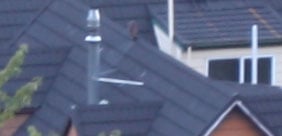 | |
100% crop, 18-55mm IS at 55mm, 1/6, 100 ISO, IS off |
100% crop, 18-55mm IS at 55mm, 1/6, 100 ISO, IS on | |
Without the lens stabilisation enabled, the slowest shutter speed with which we could achieve a sharp image (at an equivalent of 88mm) was 1/50, whereas with IS enabled we achieved sharp results down to shutter speeds of 1/6. You can see 100% crops taken from the 1/6 samples above.
A shutter of 1/6 corresponds to three stops of compensation over the 1/50 non-stabilised shot, and four stops over the 1/100 speed suggested by traditional advice. As always, the lens, conditions and the photographer themselves can produce different results. Achieving three stops of compensation in real-life is a respectable result for the lens.
Canon EOS 450D / Rebel XSi focusing
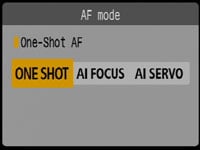 |
 |
The Canon EOS 450D / XSi is equipped with a 9-point wide-area AF system with a centre cross sensor; the diamond arrangement of the AF points and their red dots to indicate which are active may appear identical to the earlier 400D / XTi, but Canon claims it’s an improved system. The three AF modes remain the same as before though: One Shot for use with still subjects, AI Servo for moving subjects, or AI Focus which lets the camera decide between the two.
Set to AI Servo and Continuous drive mode, the EOS 450D / XSi with its kit lens zoomed-into 55mm managed to stay-focused on vehicles approaching at up to 50kph.
Canon EOS 450D / XSi metering
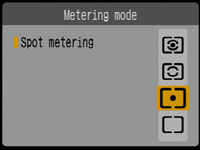 |
The Canon EOS 450D / XSi offers four metering modes: 35-zone TTL Evaluative, Partial (9% of v/f area), Spot (4% of v/f area) and Center-weighted. Spot-metering is new to the 450D / XSi over its predecessor and a welcome feature to have on this model; the viewfinder also indicates the spot metering area with a circle.
We used Evaluative metering for all our sample images and found very few occasions when we’d want to apply any compensation. Interestingly, when we used the 450D / XSi alongside the earlier 400D / XTi to shoot identical compositions, the new model typically metered the scene as being around half a stop darker – it therefore delivered images in automatic which were half a stop brighter than its predecessor. This comes as some relief as the earlier 400D / XTi often underexposed with many owners leaving their models with +1/3 or +2/3 EV of compensation permanently dialled-in.
Canon EOS 450D / XSi anti dust
 |
The EOS 450D / XSi offers the same three techniques as the EOS 40D to combat dust: anti-static coatings and materials to reduce it sticking in the first place, a vibrating filter which tries to shake-free the more stubborn particles, and a software-based solution which maps the position of any pesky marks and appends them to images for automatic removal later using the supplied Digital Photo Professional software.
Following our usual DSLR torture-test we left our 450D / XSi face-up without a lens, inside and outside for ten minutes each; we can’t know how much dust entered the body during this time, nor even how much was present to start with, but we know such a process would result in dust being a problem for most models. We then updated the 450D / XSi’s Dust Delete Data and powered the camera on and off twice to vibrate the filter.
We then took a series of photos at every aperture setting of a plain white surface at close range with the EF-S 18-55mm IS lens zoomed-into 55mm and manually focused to infinity. Dust marks normally become most apparent at the smallest apertures (eg f16 and f22), but it’s also important to test at more common apertures.
|
Canon EOS 450D / XSi dust example at f22 / f8 | ||
 | ||
100% crop, 18-55mm at 55mm, f22 |
100% crop, 18-55mm at 55mm, f8 | |
At f22, two dust marks were faintly visible on the image and we’ve cropped the darkest of the two above on the left. Applying Auto Levels to the image in Photoshop revealed a number of other dust marks, but these were essentially invisible on the f22 image.
At f16, the darkest marks were still just visible, but by f11, they’d grown sufficiently diffuse to essentially disappear. At f8, there was no sign of any, and to illustrate this we’ve cropped the exact same area from the f8 sample and shown it above right. If you save this image to your computer and apply Auto Levels, you’ll see the dust mark almost touching the top and bottom of the frame.
Strangely, like the EOS 40D though, we couldn’t get the Dust Delete Option to work on the 450D / XSi. The camera confirmed the data had been acquired, but Digital Photo Professional claimed it wasn’t present on any of our subsequent JPEG or RAW files.
So like most DSLRs, dust can get into the 450D / XSi and remain present even after the filter has been vibrated. But we’ve seen worse examples and the fact they’re hard to spot even at f16 is some consolation. That said, if you change lenses regularly, you’ll still need to occasionally rely on the manual cleaning technique of opening the shutter and using a blower.
Canon EOS 450D / Rebel XSi sensor and processing
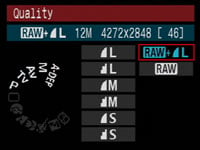 |
The Canon EOS 450D / XSi is equipped with a new 12.2 Megapixel CMOS sensor, measuring 22.2×14.8mm. It generates 3:2 aspect ratio images with a maximum resolution of 4272×2848 pixels and there’s the choice of two lower resolutions. All three sizes can be recorded with either Fine or Normal compression. Alternatively you can record RAW files either with or without a Large Fine JPEG; the 40D’s curious sRAW option is not present.
The EOS 450D / XSi also employs the most recent DiG!C III processor which allows the analogue signal to be converted into digital using 14 bits of resolution, and this 14-bit tonal detail is also recorded in the RAW images. This is an improvement over the 12-bit system of its predecessor and indeed most DSLRs.
In practice, the 450D / XSi’s RAW files certainly contained additional tonal detail over the JPEGs, although on unmodified images it could be very subtle. Where the RAW files really came into their own though was during tonal adjustments. You could make serious adjustments to the RAW files and still be left with an uninterrupted tonal range, when the matching JPEG’s histogram after the same adjustment would look like a comb.
Best quality Large Fine JPEGS typically measure between 3.4 and 6.9 MB each, while RAW files measure 17 to 20 MB each. There’s no dedicated button for the quality settings, but it is the top setting on the first menu page.
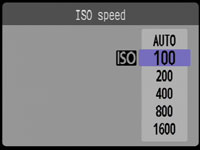 |
|
The sensitivity runs between 100 and 1600 ISO, and sadly no amount of searching in the Custom Function menu will reveal a hidden 3200 ISO ‘Hi’ option; this is quite unusual for today’s DSLRs to max-out at 1600 ISO, although perhaps Canon’s held it back due to the high resolution of the sensor. Certainly, the Sony A350 ain’t pretty at 3200 ISO. If Highlight Tone Protection is enabled, the 450D / XSi’s sensitivity range is 200-1600 ISO.
In Auto ISO, the 450D / XSi appears to choose from a range between 200 and 800 ISO – we couldn’t persuade it to select either 100 or 1600 ISO even when pointing at the Sun or in dark conditions respectively. Strangely if the sensitivity is set to Auto and the shooting mode is either Manual or with the flash, then the ISO is set to 400 ISO. On the upside, the 450D / XSi does reveal what ISO it’s going to use both on the screen and in the viewfinder as you half-press the shutter release, but you may prefer to manually select the ISO to get exactly the result you’re after.
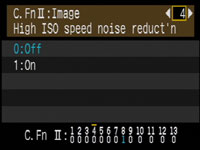 |
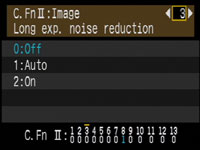 |
Like the EOS 40D, two noise reduction modes are available in the Custom Functions: High ISO Noise Reduction is actually applied throughout the range, but particularly at higher sensitivities, while Long Exposure Noise Reduction uses dark-frame subtraction. Both are disabled by default.
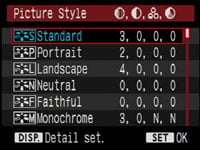 |
Pressing the White Balance button allows you to choose from Auto, Daylight, Shade, Cloudy, Tungsten, White Fluorescent, Flash and Custom – there’s no option to manually select a colour temperature in Kelvin, but there are White Balance correction and bracketing options available.
Sharpness, Contrast, Saturation and Colour Tone are applied using a number of Picture Styles: for colour photography, you have the choice of Standard, Portrait, Landscape, Neutral and Faithful, while a further Monochrome option offers four filter and four toning effects. Contrast, Saturation and Colour Tone can be adjusted in a range of +/-3, while Sharpness is offered from 0 to 7. While it’s possible to tweak these presets or configure your own with the three custom modes in-camera, software supplied with 450D / XSi lets you create and edit precision Picture Styles to your absolute requirements – just like the EOS 40D.
We used the default Standard Picture Style for most of our sample images, and found it delivered very smooth images, albeit ones which could stand a little additional sharpening. Increasing this by a notch, or shooting in RAW could reveal a lot more detail without undesirable artefacts, as shown in our Results pages.
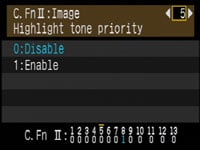 |
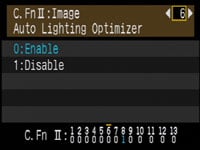 |
Leveraging the 450D / XSi’s 14-bit A-D conversion is the Highlight Tone Priority (HTP) option, inherited from the higher-end EOS 40D and buried away in one of the custom function menus. According to Canon, this improves the highlight detail by expanding the dynamic range from the standard 18% grey to bright highlights. This option is only available between 200 and 1600 ISO and Canon warns noise could be increased in shadow areas.
The 450D / XSi also features an Auto Lighting Optimiser mode to adjust the brightness and contrast, which is applied all the time in the Auto and Scene Preset modes. It’s also applied by default when you’re shooting in PASM or A-DEP modes, although a Custom Function allows you to disable it in these modes if you prefer. Since it’s enabled by default though, you’ll see it in action in all our sample images. Note, it is not applied to any RAW images, or in RAW plus JPEG mode.
Interestingly, Auto Lighting Optimiser was also present on the EOS 40D, but implemented slightly differently. Like the 450D / XSi, it’s applied by default on the EOS 40D’s Auto and Scene modes, but unlike the 450D / XSi it’s not available in the PASM or A-DEP modes. The 450D / XSi additionally exploits face detection under the hood to brighten people’s faces in strongly backlit compositions.
To put both technologies to the test we shot one of our standard Gallery compositions first with both modes disabled, then with Auto Lighting Optimiser enabled, followed by the Highlight Tone Priority (with Auto Lighting disabled). Reduced versions of each image are shown below, along with screengrabs of their histogram and exposure details taken from the 450D / XSi. As a predominantly white object photographed in bright sunlight, it’s not surprising to find portions of the boat’s deck have become clipped under normal circumstances.
Canon EOS 450D / XSi HTP and ALO disabled |
Canon EOS 450D / XSi Auto Lighting Optimiser on (default) |
Canon EOS 450D / XSi Highlight Tone Priority on | ||
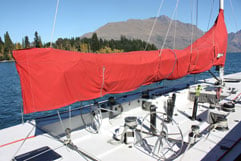 |
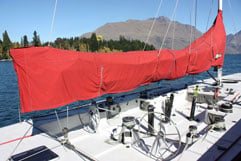 |
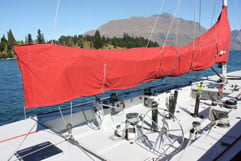 | ||
100 ISO |
100 ISO |
200 ISO | ||
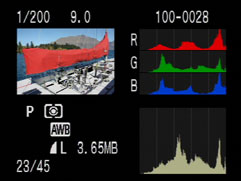 |
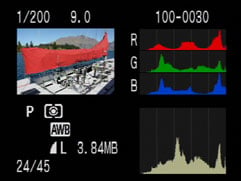 |
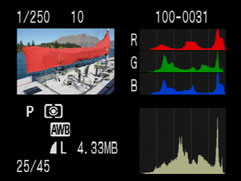 | ||
histogram and exposure details |
histogram and exposure details |
histogram and exposure details |
At first glance, the version in the middle with the Auto Lighting Optimiser enabled appears to have boosted the contrast a little for a punchier, more consumer-friendly overall image. This is most apparent in the red covering for the sail and is the 450D / XSi’s default setting. The brightest highlight areas in both samples remain clipped though.
Highlight Tone Priority is designed to protect bright highlights and indeed it’s done just that in the third sample. It’s not that easy to see in the main image, but a quick glance at the histogram below it instantly reveals the bright highlights have been reigned-in with no clipping on the far right of the scale as a consequence.
This is a good result, although there is a penalty to pay. The increase to 200 ISO and tweaking of the dynamic range has indeed increased the noise levels in shadow areas, although since these are minimal in such compositions, it can still be a useful tool to have at your disposal. Anyone photographing predominantly bright white subjects like wedding dresses or snowy landscapes (as seen in our EOS 40D review) will benefit, but for general photography you should probably not use it.
Canon EOS 450D / XSi drive modes and remote control
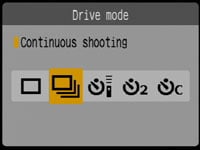 |
The Canon EOS 450D / XSi offers one continuous shooting option, rated at 3.5fps – this is slightly quicker than the 3fps of its predecessor and the 2.5fps of arch-rival, the Sony Alpha A350. To put it to the test we fitted the 450D / XSi with a SanDisk Ultra II SD memory card, set the shutter speed to 1/500 and timed burst sequences at a variety of quality settings.
With the 450D / XSi set to Large Fine JPEG, we fired-off 58 shots in 16.6 seconds before the camera’s rate slightly slowed; this corresponds to a rate of almost exactly 3.5fps. Switching to RAW mode allowed us to capture six frames in 1.7 seconds before the rate fell to one frame every second and a half or so. The first six shots were again captured at a rate of almost exactly 3.5fps.
So the 450D / XSi performs to its 3.5fps specification and shoots comfortably quicker than the Sony Alpha A350, which in our tests came out at about 2.35fps. This extra speed will be welcomed by anyone shooting action sequences, but it’s still not a patch on the 6.5fps of Canon’s own EOS 40D. That said, the 450D / XSi does feel quicker than its predecessor not only in continuous shooting, but also in general response.
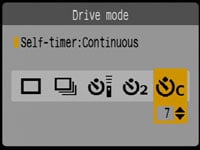 |
Anyone familiar with the EOS 400D / XTi will be pleased to find the 10 second self timer has been replaced by a 2 second timer (with optional mirror-lockup) and a custom timer option which counts-down from 10 seconds, but then takes your choice of one to ten photos in quick succession – handy to stop you returning to the camera for a second or third attempt.
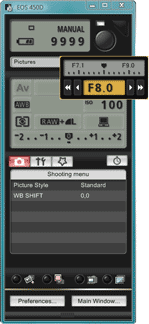 |
Like the higher-end EOS 40D, the EOS Utility software supplied with the EOS 450D / XSi additionally allows you to remote control the camera over a USB connection and record images direct to your computer’s hard disk. This lets you use your PC or Mac as an inter-valometer, pre-program long exposures in Bulb mode, and even both focus the lens and preview the image on your monitor thanks to Live View.
You can remote control and adjust pretty much any setting that doesn’t involve a physical dial or switch. So you can’t change the exposure mode from, say, Aperture to Shutter Priority using the software, but you can adjust the aperture or shutter value, the quality, white balance, metering or sensitivity for example. It’s particularly fun to adjust the focusing remotely on your computer screen using the Live View, especially fine-tuning with the magnified option. Then when you’re ready, just click the ‘button’ in the top right of the EOS Utility window to take the shot. These can be recorded direct to your hard disk, onto the camera’s memory card or both for additional security.
This is a wonderful feature to have, especially for a camera at this price-point, and if you have a laptop handy, it could even eliminate the need for certain photographers to invest in a cable release. In fact the only downside we could find was the inability for the USB port to power the camera itself, thereby making an AC adapter mandatory for serious unattended time-lapse photography. And the only advantage the higher-end EOS 40D has over the 450D / XSi in this respect is the optional WFT-E3(A) accessory which allows remote control over a wired or wireless network connection. See our 450D / XSi video tour for a demonstration or head straight to our 450D / XSi results.





